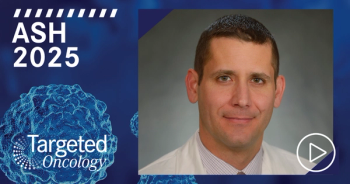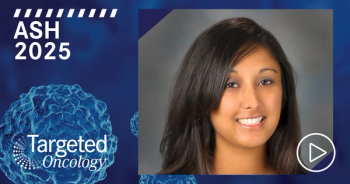
Case-Based Roundtable Meetings Spotlight
- Case-Based Roundtable Meetings Spotlight June 2021: Hematologic Malignancies
Roundtable Discussion: Gordon Explores Second-line Transplant and CAR T-Cell Therapy for DLBCL
During a Targeted Oncology Case-Based Roundtable events, Leo I. Gordon, MD, led a discussion about second-line treatment of diffuse large B-cell lymphoma.
During a Targeted Oncology Case-Based Roundtable events, Leo I. Gordon, MD, led a discussion about second-line treatment of diffuse large B-cell lymphoma (DLBCL).
MATTOUR: Usually, it’s a combination of all of the above. Not so much age as a number, but it’s the functional age of the patient that guides a lot of [treatment decisions]— but if you have somebody who’s 80 years old, they are not going to be eligible.
GORDON: I think that difference [between chronological age and functional age] is important because we’ve [performed a] transplant for people into their mid-70s, and then there are some people in their mid-60s that we wouldn’t consider for transplant based on other factors, such as comorbidities, cardiac history, renal dysfunction, and hepatic dysfunction. Most of those comorbidities tend to occur more frequently in people in a higher age group.
Patient preference sometimes [comes up], but we haven’t found that to be a major issue, although, I think it can be, with access issues [as well]. I think in 2021, I can speak for people in every environment where there’s access to either a tertiary care medical center or a very large practice, and autologous stem cell transplants are done routinely. If access includes insurance, that’s potentially an issue. Our experience has been [that access] from an insurance standpoint shouldn’t really be a problem because transplant is the standard of care for second-line treatment, at least as of this moment.
My major reason for not doing a transplant has been insufficient response. There’s a lot of debate about what kind of response to a second-line treatment you would need to proceed to an autologous transplant. I think my own bias is that patients should be in complete metabolic remission or near complete metabolic remission prior to proceeding to transplant. Nirav N. Shah, MD, from Medical College of Wisconsin, representing the CIBMTR [Center for International Blood & Marrow Transplant Research], recently reported that even in patients with a partial response, about 41% can have long-term progression-free survival after an autologous transplant even though they’ve had active disease.1 That’s not been our experience, but that’s certainly something to bear in mind.
GORDON: That could mean a number of things. I would define primary refractory as those patients who don’t achieve complete remission [CR] with first-line treatment or who achieve a CR that lasts less than a year. I would consider [those patients] primary refractory for most clinical trial eligibility definitions. Those are the guidelines I think [health care providers] are using.
GORDON: What proportion (of patients) would you say in your practice and your experience are primary refractory?
CHOWDHARY: I haven’t found many. I think the numbers have been very low….I’ve rarely had anyone who really has not responded to frontline R-CHOP [cyclophosphamide, doxorubicin, vincristine, and prednisone]. At least in my case, I have rarely had a patient with primary refractory DLBCL.
GORDON: I think that in a regular practice, that’s probably true. A lot of what we see are referrals, so we might see some more [patients with primary refractory disease] because those are the individuals we might see for trials or just for an opinion. Would you say probably less than 10% of your patients [are primary refractory]?
CHOWDHARY: Yes, that’s what I would put the number.
GORDON: I think that’s quite reasonable. In our primary care experience, that’s probably right. When you add in the referral base, it probably comes up to maybe 20% or something like that. If you look across the board at both [patients who are] primary refractory and patients who relapsed at some point, we’re now in the rituximab [era], expecting that as many as 60% or 70% of patients with DLBCL might be cured with their initial chemotherapy, whether it’s R-CHOP or [another chemotherapy] regimen. I think we’re talking about maybe 30% or at the most maybe 40% of patients who might either be primary refractory or who relapsed at some point along the course. Most of those relapses happen in the first couple of years, although we have occasionally seen relapses late.
GORDON: What would you say the options are in a patient who relapses at a year out at 75 years of age?
CHOWDHARY: When you’re looking at a second-line regimen [and it’s been] about a year since the last regimen, I think chemoimmunotherapy is still an attractive option. Bendamustine/rituximab is 1 option. You want to look at safety, tolerability, and comorbidities at this time to weigh into that decision. I think another good option would be lenalidomide [Revlimid] with rituximab. I think that would be an attractive option, as well, because quality of life is going to be important. Bendamustine/rituximab/ibrutinib [Imbruvica] and even CAR [chimeric antigen receptor] T-cell therapy would be options, too. I think these are the 4 options I’d look at. I think deciding between them is the bigger question.
GORDON: One of the questions I always ask myself here is whether we are headed for a transplant.…I would probably add rituximab/gemcitabine/oxaliplatin [R-GemOx] [to the regimens you mentioned]; R-GemOx or rituximab plus DHAP [dexamethasone/high-dose cytarabine/cisplatin].
Rituximab/ifosfamide/carboplatin/etoposide [R-ICE] is a regimen that leads us to transplant. In this setting, I might not do that, although in some patients, it’s as well tolerated as R-CHOP. My experience for a second-line regimen in this setting is R-GemOx.
Your question about CAR T cells is an excellent one. We just completed the TRANSCEND-PILOT-017006 trial [NCT03483103] for patients with DLBCL in their first relapse after 1 prior treatment with either R-CHOP, or R-EPOCH [rituximab, etoposide, prednisone, vincristine, cyclophosphamide, doxorubicin], anthracycline-based treatment. This was a phase 2 study looking at JCAR17 [lisocabtagene maraleucel; Breyanzi], which was recently approved. In order to be a candidate for that study, patients had to either be over 70 years old or have compromised renal or cardiac function, but not so compromised as to make them not candidates for CAR T therapy It’s a narrow window of patients, but we were pretty active in that group. We still have patients that are doing well. We only have follow-up of a little less than a year and a half or so with just CAR T-cell therapy, with no bridging. [Bridging] might be an option later.
There are 3 clinical trials [of CAR T-cell therapy] that have been completed [or are ongoing now]. One is the ZUMA-7 trial [NCT03391466] from Kite using Yescarta [axicabtagene ciloleucel] versus transplant; one is the BELINDA trial [NCT03570892] from Novartis using Kymriah [tisagenlecleucel] versus transplant; and one is the TRANSCEND trial using JCAR17 versus transplant in a randomized fashion.
Because ZUMA-7 was the first, we will probably get some sense of what that looked like at the American Society of Hematology [ASH] meeting this year, although I can’t say that for sure. I think that by ASH this year, we may have an initial look at the data in that trial that asks this critical question: Should we move right to CAR T therapy or transplant, not only in individuals over 70, but in everybody with DLBCL who relapses?
GORDON: CAR T, unfortunately, is not really an option unless you can get an insurance company to approve for the second line; most will not. We have been successful once or twice. Low-intensity chemotherapy would be something like R-GemOx, bendamustine/rituximab, or lenalidomide/rituximab. High-intensity chemotherapy would be DHAP, ICE, or ESHAP [etoposide, methylprednisolone, high-dose cytarabine, cisplatin]. Most of those are [used] on the way to transplant.
Then the new options [in the poll] for second- or third-line therapy for DLBCL were the combination of tafasitamab-cxix [Monjuvi] plus lenalidomide or other. Most people said low-intensity chemotherapy, a few said high-intensity chemotherapy, and then about 15% said tafasitamab and lenalidomide. CAR T was 0 because it’s not approved, but this may change in the next year.
GORDON: If you look carefully at the NCCN [National Comprehensive Cancer Network] guidelines that we put together with [tafasitamab], there’s a small footnote that says that in patients who might be candidates for CAR T-cell therapy later on, the use of any CD19-targeted therapy might limit the response to CAR T-[cell] therapy later. We don’t know that.2
When you talk to the [investigators] doing the [CAR T] studies, they say they have data that suggest that individuals respond fine. In our clinical trial of JCAR17, if people were exposed to a CD19-containing regimen and there weren’t as many around at the time of the trial, they had to have a repeat biopsy demonstrating CD19 positivity. The concern is that you could lose the target. We don’t know the answer to that. Biopsy and immunohistochemistry, especially for CD19, can be hit or miss.
[It doesn’t always show up], even though you know it’s there because CD20 is there. If you look at up-and-coming off-the-shelf AlloCAR T therapy trials, individuals who have had CD19-containing therapy are not eligible for those trials.
I think it’s something to bear in mind. If you don’t think CAR T is a likely possibility down the road and you think that [tafasitamab and lenalidomide] is really the way you want to go, then I think this becomes a very active agent and a good option. If you’re thinking CAR T, it’s still probably a good option but just with some caution. That’s the [footnote] in the NCCN guidelines. But I think it’s an important new agent for refractory DLBCL.
GORDON: Under what circumstances would you be most likely to use versus not use tafasitamab/lenalidomide in the second line?
KIM: I think it would depend on whether you’re thinking [of using] CAR T afterward. I don’t know that I would necessarily go with this as the next line, but if the patient was very elderly or frail, transplant ineligibility doesn’t mean they’re not eligible for CAR T. I think that would be a decision maker. I think, also, burden of disease might play a role. If [patients] had heavy disease burden or if they were primary refractory and they still had a significant amount of disease left, I may favor more chemotherapy- based regimens over novel targeted therapy and an antibody.
I think those are probably the main things. Some barriers that I could potentially see are the number of visits for patients. At least with the first 3 cycles, it’s almost weekly infusions, so that might be more difficult [for patients]. If they were frail or elderly or if they had issues with transportation, those are all things that might affect the ability to use this for certain patients.
GORDON: All excellent points. I think all those things play a role. It’s an infusion. Something like R-GemOx is a well-tolerated regimen. It is every 2 weeks, but fairly quick. It just gives us options to think about.
REFERENCES
1. Shah NN, Ahn KW, Litovich C, et al. Is autologous transplant in relapsed DLBCL patients achieving only a PET+ PR appropriate in the CAR T-cell era? Blood. 2021;137(10):1416-1423. doi:10.1182/blood.2020007939
2. NCCN. Clinical practice guidelines in oncology. B-cell lymphomas; version 4.2021. Accessed May 17, 2021. https://bit.ly/3eQzRkX








































